Dynamic Acoustic Unit Augmentation with BPE-Dropout for Low-Resource End-to-End Speech Recognition
Abstract
1. Introduction
2. ASR Modeling
2.1. Hybrid Approach
- Acoustic and language models are built separately from each other and have their different objective functions. This significantly complicates the process of optimizing the ASR system.
- To train the final DNN-based acoustic model, a hard alignment (mapping of each input feature frame to a target acoustic unit) is required. It is generated and refined through several iterations of GMM-HMM-based training, in which the condition-independent assumption is in effect. However, this hard alignment also limits the acoustic context that the model can process before emitting the target token’s spike.
- Decoding with WFST graph is highly memory intensive, which makes it difficult to use the approach in ASR tasks for smart devices where the memory is severely limited.
2.2. End-to-End Approaches
3. Subword Modeling
3.1. ULM Subword Regularization
3.2. BPE-Dropout Augmentation
4. Method Description
4.1. Dynamic Acoustic Unit Augmentation
4.2. Recognition of OOV Words
5. Experiments
5.1. Data
5.2. End-to-End Setup
5.3. The Augmentation Impact
5.4. Final Comparison
6. Discussion
7. Limitations
- While the proposed acoustic unit augmentation approach significantly improves the OOV recognition rate, it is still cannot compete with or replace explicit personalization techniques for those personalized ASR tasks where the quality is more important than the speed.
- Since the use of BPE-dropout shifts the distribution of acoustic units towards shorter ones, the expected quality improvement might diminish if the method is applied to a system with a higher frame subsampling factor (e.g., 8 or 16).
- The end-to-end systems used in this study may not be suitable for the use in smart assistants “as is”, as the research focus was on the quality improvement. Additional enhancements may be required to make the systems more efficient (e.g., model compression, decoding optimization, and streaming training mode). Our best Conformer model has almost 40 million parameters. Its decoding (inference on GPU Nvidia GTX 1080TI and beam search on CPU) has nine real-time (RT) (calculated as the total test set duration divided by the decoding time). After moving to an edge device, the speed will drop significantly, which can make our model impractical for the real-time ASR. In particular, 1080TI has 11.34 tera floating-point operations per second (TFLOPs), while, for example, Nvidia Jetson TX2 Series devices have 0.67 TFLOPs.
- The data used in this study may not be sufficient to build an effective ASR system for smart assistants. It may require augmenting telephone waveforms with synthetic room impulse responses and extending them with target microphone data.
8. Conclusions
Author Contributions
Funding
Institutional Review Board Statement
Informed Consent Statement
Data Availability Statement
Conflicts of Interest
Abbreviations
| MDPI | Multidisciplinary Digital Publishing Institute |
| ASR | Automatic Speech Recognition |
| OOV | Out-Of-Vocabulary |
| CER | Character Error Rate |
| WER | Word Error Rate |
| LVCSR | Large Vocabulary Continuous Speech Recognition |
| HMM | Hidden Markov Model |
| DNN | Deep Neural Network |
| BPE | Byte Pair Encoding |
| ULM | Unigram Language Model |
| MT | Machine Translation |
| WFST | Weighted Finite-State Transducer |
| CTC | Connectionist Temporal Classification |
| RNN | Recurrent Neural Network |
| MHA | Multi-Head (Self) Attention |
| IARPA | Intelligence Advanced Research Projects Activity |
| GPU | Graphics Processing Unit |
| CNN | Convolutional Neural Network |
| CONV2D | 2D CNN |
| SP | speed perturbation |
| LF-MMI | Lattice-Free-Maximum Mutual Information (Criterion) |
| TDNN-F | Time Delay Neural Network-Factorized |
| BLSTM | Bidirectional Long Short-Term Memory |
| VGG | Visual Geometry Group |
| RT | Real Time |
| TFLOPs | FLoating-point Operations Per second |
References
- Olson, C.; Kemery, K. Voice Report: From Answers to Action: Customer Adoption of Voice Technology and Digital Assistants; Microsoft. Available online: https://about.ads.microsoft.com/en-us/insights/2019-voice-report (accessed on 26 December 2020).
- Pal, D.; Arpnikanondt, C.; Funilkul, S.; Varadarajan, V. User Experience with Smart Voice Assistants: The Accent Perspective. In Proceedings of the IEEE 10th International Conference on Computing, Communication and Networking Technologies (ICCCNT), Kanpur, India, 6–8 July 2019; pp. 1–6. [Google Scholar] [CrossRef]
- Sainath, T.; He, Y.; Li, B.; Narayanan, A.; Pang, R.; Bruguier, A.; Chang, S.Y.; Li, W.; Alvarez, R.; Chen, Z.; et al. A Streaming On-Device End-To-End Model Surpassing Server-Side Conventional Model Quality and Latency. In Proceedings of the IEEE International Conference on Acoustics, Speech and Signal Processing (ICASSP), Barcelona, Spain, 4–8 May 2020; pp. 6059–6063. [Google Scholar] [CrossRef][Green Version]
- Huang, W.; Hu, W.; Yeung, Y.T.; Chen, X. Conv-Transformer Transducer: Low Latency, Low Frame Rate, Streamable End-to-End Speech Recognition. In Proceedings of the Interspeech 2020, ISCA, Shanghai, China, 25–29 October 2020; pp. 5001–5005. [Google Scholar] [CrossRef]
- Sigtia, S.; Haynes, R.; Richards, H.; Marchi, E.; Bridle, J. Efficient Voice Trigger Detection for Low Resource Hardware. In Proceedings of the Interspeech 2018, ISCA, Hyderabad, India, 2–6 September 2018; pp. 2092–2096. [Google Scholar] [CrossRef]
- Hinton, G.; Deng, L.; Yu, D.; Dahl, G.E.; Mohamed, A.; Jaitly, N.; Senior, A.; Vanhoucke, V.; Nguyen, P.; Sainath, T.N.; et al. Deep neural networks for acoustic modeling in speech recognition: The shared views of four research groups. Signal Process. Mag. IEEE 2012, 29, 82–97. [Google Scholar] [CrossRef]
- Graves, A.; Fernández, S.; Gomez, F.; Schmidhuber, J. Connectionist temporal classification: Labelling unsegmented sequence data with recurrent neural networks. In Proceedings of the 23rd international conference on Machine learning—ICML, Pittsburgh, PA, USA, 25–29 June 2006; pp. 369–376. [Google Scholar] [CrossRef]
- Chan, W.; Jaitly, N.; Le, Q.V.; Vinyals, O. Listen, attend and spell: A neural network for large vocabulary conversational speech recognition. In Proceedings of the IEEE International Conference on Acoustics, Speech and Signal Processing (ICASSP), Shanghai, China, 20–25 March 2016; pp. 4960–4964. [Google Scholar] [CrossRef]
- Aleksic, P.; Allauzen, C.; Elson, D.; Kracun, A.; Casado, D.M.; Moreno, P.J. Improved recognition of contact names in voice commands. In Proceedings of the IEEE International Conference on Acoustics, Speech and Signal Processing (ICASSP), South Brisbane, Australia, 19–24 April 2015; pp. 5172–5175. [Google Scholar]
- Tulsiani, H.; Sapru, A.; Arsikere, H.; Punjabi, S.; Garimella, S. Improved Training Strategies for End-to-End Speech Recognition in Digital Voice Assistants. In Proceedings of the Interspeech 2020, ISCA, Shanghai, China, 25–29 October 2020; pp. 2792–2796. [Google Scholar] [CrossRef]
- Khokhlov, Y.; Tomashenko, N.; Medennikov, I.; Romanenko, A. Fast and Accurate OOV Decoder on High-Level Features. In Proceedings of the Interspeech 2017, ISCA, Stockholm, Sweden, 20–24 August 2017; pp. 2884–2888. [Google Scholar] [CrossRef]
- Gandhe, A.; Rastrow, A.; Hoffmeister, B. Scalable Language Model Adaptation for Spoken Dialogue Systems. In Proceedings of the IEEE 2018 Spoken Language Technology Workshop (SLT), Athens, Greece, 18–21 December 2018; pp. 907–912. [Google Scholar] [CrossRef]
- Malkovsky, N.; Bataev, V.; Sviridkin, D.; Kizhaeva, N.; Laptev, A.; Valiev, I.; Petrov, O. Techniques for Vocabulary Expansion in Hybrid Speech Recognition Systems. arXiv 2020, arXiv:2003.09024. [Google Scholar]
- Smit, P.; Virpioja, S.; Kurimo, M. Improved Subword Modeling for WFST-Based Speech Recognition. In Proceedings of the Interspeech 2017, ISCA, Stockholm, Sweden, 20–24 August 2017; pp. 2551–2555. [Google Scholar] [CrossRef]
- Jain, M.; Keren, G.; Mahadeokar, J.; Zweig, G.; Metze, F.; Saraf, Y. Contextual RNN-T for Open Domain ASR. In Proceedings of the Interspeech 2020, ISCA, Shanghai, China, 25–29 October 2020; pp. 11–15. [Google Scholar] [CrossRef]
- Sennrich, R.; Haddow, B.; Birch, A. Neural Machine Translation of Rare Words with Subword Units. In Proceedings of the 54th Annual Meeting of the Association for Computational Linguistics (Volume 1: Long Papers); Association for Computational Linguistics: Berlin, Germany, 2016; pp. 1715–1725. [Google Scholar] [CrossRef]
- Kudo, T. Subword Regularization: Improving Neural Network Translation Models with Multiple Subword Candidates. In Proceedings of the 56th Annual Meeting of the Association for Computational Linguistics (Volume 1: Long Papers); Association for Computational Linguistics: Melbourne, Australia, 2018; pp. 66–75. [Google Scholar] [CrossRef]
- Creutz, M.; Lagus, K. Unsupervised Discovery of Morphemes. In Proceedings of the ACL-02 Workshop on Morphological and Phonological Learning; Association for Computational Linguistics: Stroudsburg, PA, USA, 2002; pp. 21–30. [Google Scholar] [CrossRef]
- Grönroos, S.A.; Virpioja, S.; Kurimo, M. Morfessor EM+Prune: Improved Subword Segmentation with Expectation Maximization and Pruning. In Proceedings of the 12th Language Resources and Evaluation Conference; ELRA: Marseilles, France, 2020. [Google Scholar]
- Provilkov, I.; Emelianenko, D.; Voita, E. BPE-Dropout: Simple and Effective Subword Regularization. In Proceedings of the 58th Annual Meeting of the Association for Computational Linguistics; Association for Computational Linguistics: Seattle, WA, USA, 2020; pp. 1882–1892. [Google Scholar] [CrossRef]
- Drexler, J.; Glass, J. Subword Regularization and Beam Search Decoding for End-to-end Automatic Speech Recognition. In Proceedings of the IEEE International Conference on Acoustics, Speech and Signal Processing (ICASSP), Brighton, UK, 12–17 May 2019; pp. 6266–6270. [Google Scholar] [CrossRef]
- Lakomkin, E.; Heymann, J.; Sklyar, I.; Wiesler, S. Subword Regularization: An Analysis of Scalability and Generalization for End-to-End Automatic Speech Recognition. In Proceedings of the Interspeech 2020, ISCA, Shanghai, China, 25–29 October 2020; pp. 3600–3604. [Google Scholar] [CrossRef]
- Tapo, A.A.; Coulibaly, B.; Diarra, S.; Homan, C.; Kreutzer, J.; Luger, S.; Nagashima, A.; Zampieri, M.; Leventhal, M. Neural Machine Translation for Extremely Low-Resource African Languages: A Case Study on Bambara. In Proceedings of the 3rd Workshop on Technologies for MT of Low Resource Languages (LoResMT 2020); Association for Computational Linguistics: Suzhou, China, 2020; pp. 23–32. [Google Scholar]
- Knowles, R.; Larkin, S.; Stewart, D.; Littell, P. NRC Systems for Low Resource German-Upper Sorbian Machine Translation 2020: Transfer Learning with Lexical Modifications. In Proceedings of the Fifth Conference on Machine Translation, Seattle, WA, USA, 19–20 November 2020; Association for Computational Linguistics: Stroudsburg, PA, USA, 2020; pp. 1112–1122. [Google Scholar]
- Libovický, J.; Hangya, V.; Schmid, H.; Fraser, A. The LMU Munich System for the WMT20 Very Low Resource Supervised MT Task. In Proceedings of the Fifth Conference on Machine Translation, online. 19–20 November 2020; Association for Computational Linguistics: Seattle, WA, USA, 2020; pp. 1104–1111. [Google Scholar]
- He, X.; Haffari, G.; Norouzi, M. Dynamic Programming Encoding for Subword Segmentation in Neural Machine Translation. In Proceedings of the 58th Annual Meeting of the Association for Computational Linguistics, Seattle, WA, USA, 6–8 July 2020; pp. 3042–3051. [Google Scholar] [CrossRef]
- Grönroos, S.A.; Virpioja, S.; Kurimo, M. Transfer learning and subword sampling for asymmetric-resource one-to-many neural translation. In Machine Translation; Springer International Publishing: Berlin/Heidelberg, Germany, 2021. [Google Scholar] [CrossRef]
- Andresen, J.; Bills, A.; Dubinski, E.; Fiscus, J.; Gillies, B.; Mary Harper, T.; Jarrett, A.; Roomi, B.; Ray, J.; Rytting, A.; et al. IARPA Babel Turkish Language Pack, IARPA-babel105bv0.5 LDC2016S10; Linguistic Data Consortium: Philadelphia, PA, USA, 2016. [Google Scholar] [CrossRef]
- Bills, A.; Conners, T.; David, A.; Dubinski, E.; Fiscus, J.; Hammond, S.; Gann, K.; Harper, M.; Hefright, B.; Kazi, M.; et al. IARPA Babel Georgian Language Pack, IARPA-babel404b-v1.0a LDC2016S12; Linguistic Data Consortium: Philadelphia, PA, USA, 2016. [Google Scholar] [CrossRef]
- Kriman, S.; Beliaev, S.; Ginsburg, B.; Huang, J.; Kuchaiev, O.; Lavrukhin, V.; Leary, R.; Li, J.; Zhang, Y. Quartznet: Deep Automatic Speech Recognition with 1D Time-Channel Separable Convolutions. In Proceedings of the IEEE International Conference on Acoustics, Speech and Signal Processing (ICASSP), Barcelona, Spain, 4–8 May 2020; pp. 6124–6128. [Google Scholar] [CrossRef]
- Graves, A. Sequence Transduction with Recurrent Neural Networks. In Proceedings of the 29th International Conference on Machine Learning—ICML, Workshop on Representation Learning, Edinburgh, Scotland, 26 June–1 July 2012. [Google Scholar]
- Li, J.; Zhao, R.; Meng, Z.; Liu, Y.; Wei, W.; Parthasarathy, S.; Mazalov, V.; Wang, Z.; He, L.; Zhao, S.; et al. Developing RNN-T Models Surpassing High-Performance Hybrid Models with Customization Capability. In Proceedings of the Interspeech 2020, ISCA, Shanghai, China, 25–29 October 2020; pp. 3590–3594. [Google Scholar] [CrossRef]
- Andrusenko, A.; Laptev, A.; Medennikov, I. Towards a Competitive End-to-End Speech Recognition for CHiME-6 Dinner Party Transcription. In Proceedings of the Interspeech 2020, ISCA, Shanghai, China, 25–29 October 2020; pp. 319–323. [Google Scholar] [CrossRef]
- Kim, S.; Hori, T.; Watanabe, S. Joint CTC-attention based end-to-end speech recognition using multi-task learning. In Proceedings of the IEEE International Conference on Acoustics, Speech and Signal Processing (ICASSP), New Orleans, LA, USA, 5–9 March 2017; pp. 4835–4839. [Google Scholar] [CrossRef]
- Vaswani, A.; Shazeer, N.; Parmar, N.; Uszkoreit, J.; Jones, L.; Gomez, A.N.; Kaiser, L.U.; Polosukhin, I. Attention is All you Need. In Advances in Neural Information Processing Systems 30 (NIPS 2017); Curran Associates, Inc.: Long Beach, CA, USA, 2017; Volume 30, pp. 5998–6008. [Google Scholar]
- Andrusenko, A.; Laptev, A.; Medennikov, I. Exploration of End-to-End ASR for OpenSTT – Russian Open Speech-to-Text Dataset. In Speech and Computer; Springer International Publishing: Cham, Switzerland, 2020; pp. 35–44. [Google Scholar] [CrossRef]
- Laptev, A.; Korostik, R.; Svischev, A.; Andrusenko, A.; Medennikov, I.; Rybin, S. You Do Not Need More Data: Improving End-To-End Speech Recognition by Text-To-Speech Data Augmentation. In Proceedings of the IEEE 2020 13th International Congress on Image and Signal Processing, BioMedical Engineering and Informatics (CISP-BMEI), Chengdu, China, 17–19 October 2020; pp. 439–444. [Google Scholar] [CrossRef]
- Gulati, A.; Qin, J.; Chiu, C.C.; Parmar, N.; Zhang, Y.; Yu, J.; Han, W.; Wang, S.; Zhang, Z.; Wu, Y.; et al. Conformer: Convolution-augmented Transformer for Speech Recognition. In Proceedings of the Interspeech 2020, ISCA, Shanghai, China, 25–29 October 2020; pp. 5036–5040. [Google Scholar] [CrossRef]
- Guo, P.; Boyer, F.; Chang, X.; Hayashi, T.; Higuchi, Y.; Inaguma, H.; Kamo, N.; Li, C.; Garcia-Romero, D.; Shi, J.; et al. Recent Developments on ESPnet Toolkit Boosted by Conformer. arXiv 2020, arXiv:2010.13956. [Google Scholar]
- Scott, S.L. Bayesian Methods for Hidden Markov Models: Recursive Computing in the 21st Century. Taylor Fr. 2002, 97, 337–351. [Google Scholar] [CrossRef]
- Alexeev, A.; Kukharev, G.; Matveev, Y.; Matveev, A. A Highly Efficient Neural Network Solution for Automated Detection of Pointer Meters with Different Analog Scales Operating in Different Conditions. Mathematics 2020, 8, 1104. [Google Scholar] [CrossRef]
- Kingma, D.P.; Ba, J. Adam: A method for stochastic optimization. In Proceedings of the 3rd International Conference on Learning Representations, ICLR, San Diego, CA, USA, 7–9 May 2015. [Google Scholar]
- Smith, L.N.; Topin, N. Super-convergence: Very fast training of neural networks using large learning rates. In Artificial Intelligence and Machine Learning for Multi-Domain Operations Applications; International Society for Optics and Photonics, SPIE: Bellingham, WA, USA, 2019; Volume 11006, pp. 369–386. [Google Scholar] [CrossRef]
- Park, D.S.; Chan, W.; Zhang, Y.; Chiu, C.C.; Zoph, B.; Cubuk, E.D.; Le, Q.V. SpecAugment: A simple data augmentation method for automatic speech recognition. In Proceedings of the Interspeech 2019, ISCA, Graz, Austria, 15–19 September 2019. [Google Scholar] [CrossRef]
- Kudo, T.; Richardson, J. SentencePiece: A simple and language independent subword tokenizer and detokenizer for Neural Text Processing. In Proceedings of the 2018 Conference on Empirical Methods in Natural Language Processing: System Demonstrations; Association for Computational Linguistics: Brussels, Belgium, 2018; pp. 66–71. [Google Scholar] [CrossRef]
- Watanabe, S.; Hori, T.; Karita, S.; Hayashi, T.; Nishitoba, J.; Unno, Y.; Enrique Yalta Soplin, N.; Heymann, J.; Wiesner, M.; Chen, N.; et al. ESPnet: End-to-End Speech Processing Toolkit. In Proceedings of the Interspeech 2018, ISCA, Hyderabad, India, 2–6 September 2018; pp. 2207–2211. [Google Scholar] [CrossRef]
- Watanabe, S.; Boyer, F.; Chang, X.; Guo, P.; Hayashi, T.; Higuchi, Y.; Hori, T.; Huang, W.C.; Inaguma, H.; Kamo, N.; et al. The 2020 ESPnet update: New features, broadened applications, performance improvements, and future plans. arXiv 2020, arXiv:2012.13006. [Google Scholar]
- Ko, T.; Peddinti, V.; Povey, D.; Khudanpur, S. Audio augmentation for speech recognition. In Proceedings of the Interspeech 2015, ISCA, Dresden, Germany, 6–10 September 2015. [Google Scholar]
- Povey, D.; Ghoshal, A.; Boulianne, G.; Burget, L.; Glembek, O.; Goel, N.; Hannemann, M.; Motlicek, P.; Qian, Y.; Schwarz, P.; et al. The kaldi speech recognition toolkit. In Proceedings of the IEEE 2011 Workshop on Automatic Speech Recognition and Understanding, IEEE Signal Processing Society, Waikoloa, HI, USA, 11–15 December 2011. [Google Scholar]
- Fisher, W.M.; Fiscus, J.G. Better alignment procedures for speech recognition evaluation. In Proceedings of the IEEE International Conference on Acoustics, Speech and Signal Processing (ICASSP), Minneapolis, MN, USA, 27–30 April 1993; Volume 2, pp. 59–62. [Google Scholar] [CrossRef]
- Bataev, V.; Korenevsky, M.; Medennikov, I.; Zatvornitskiy, A. Exploring end-to-end techniques for low-resource speech recognition. In Proceedings of the International Conference on Speech and Computer, Leipzig, Germany, 18–22 September 2018; pp. 32–41. [Google Scholar] [CrossRef]
- Cho, J.; Baskar, M.K.; Li, R.; Wiesner, M.; Mallidi, S.H.; Yalta, N.; Karafiát, M.; Watanabe, S.; Hori, T. Multilingual Sequence-to-Sequence Speech Recognition: Architecture, Transfer Learning, and Language Modeling. In Proceedings of the 2018 IEEE Spoken Language Technology Workshop (SLT), Athens, Greece, 18–21 December 2018; pp. 521–527. [Google Scholar] [CrossRef]
- Conneau, A.; Baevski, A.; Collobert, R.; Mohamed, A.; Auli, M. Unsupervised cross-lingual representation learning for speech recognition. arXiv 2020, arXiv:2006.13979. [Google Scholar]
- Alumäe, T.; Karakos, D.; Hartmann, W.; Hsiao, R.; Zhang, L.; Nguyen, L.; Tsakalidis, S.; Schwartz, R. The 2016 BBN Georgian telephone speech keyword spotting system. In Proceedings of the IEEE International Conference on Acoustics, Speech and Signal Processing (ICASSP), New Orleans, LA, USA, 5–9 March 2017; pp. 5755–5759. [Google Scholar] [CrossRef]
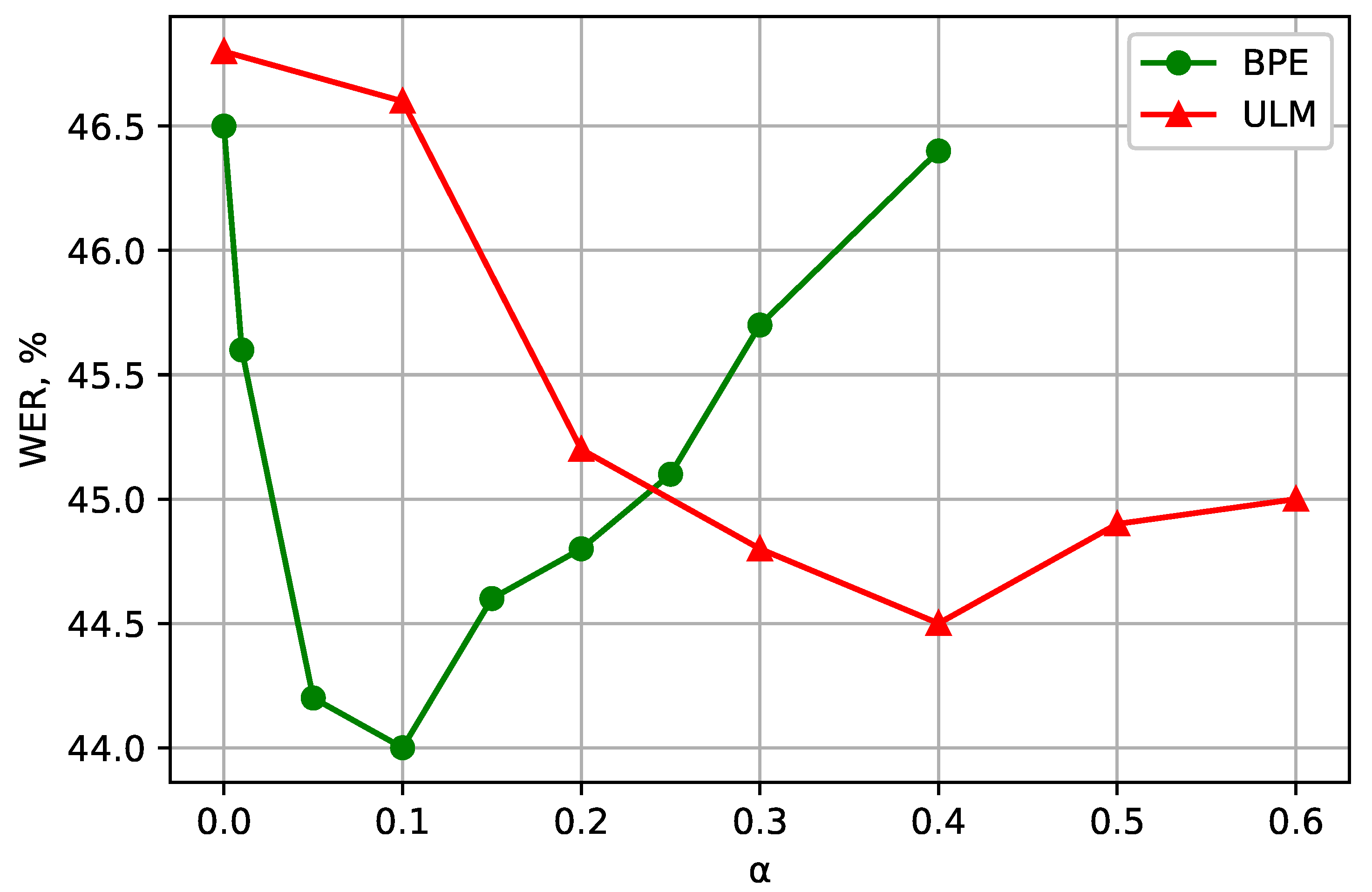
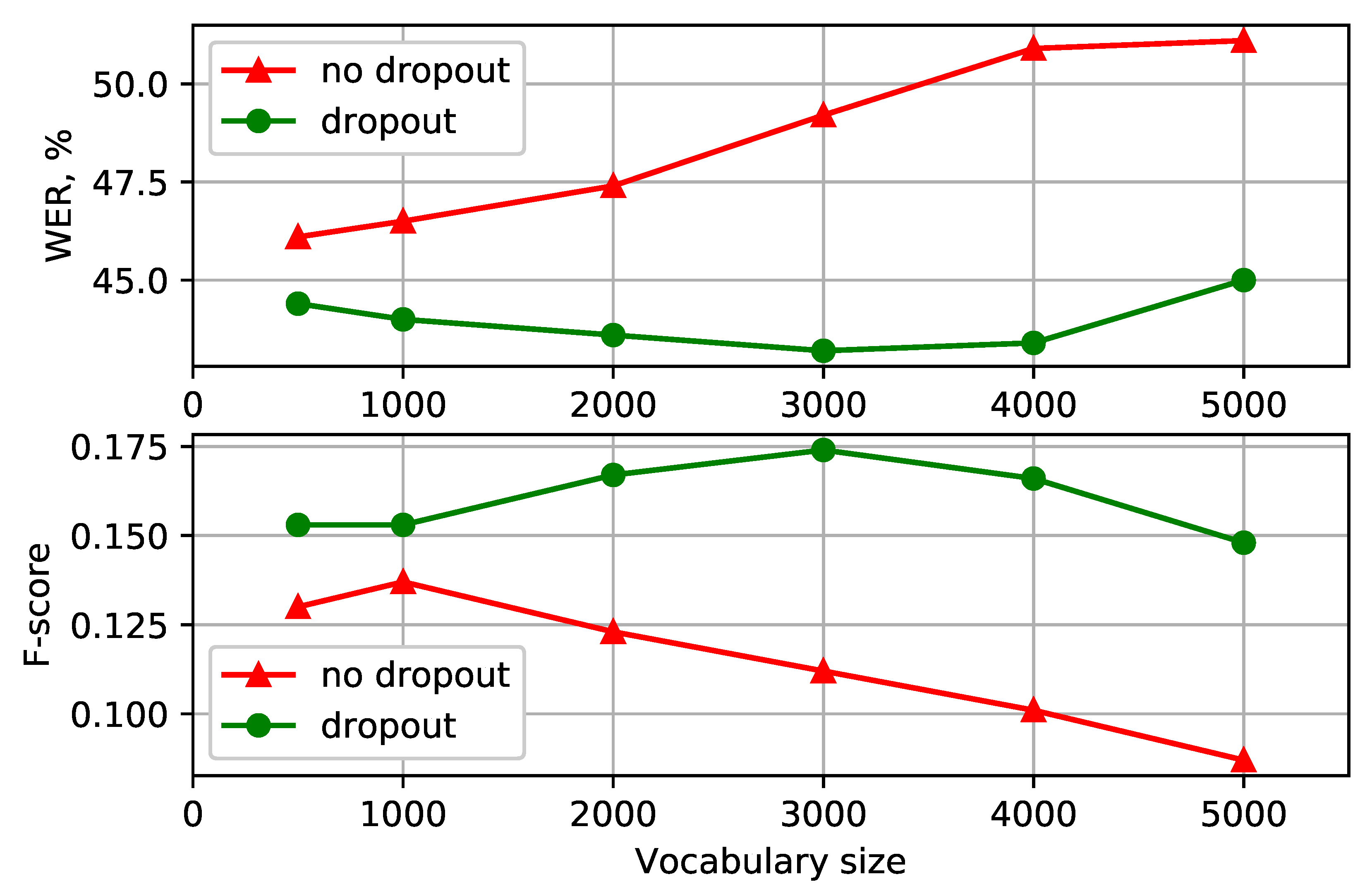
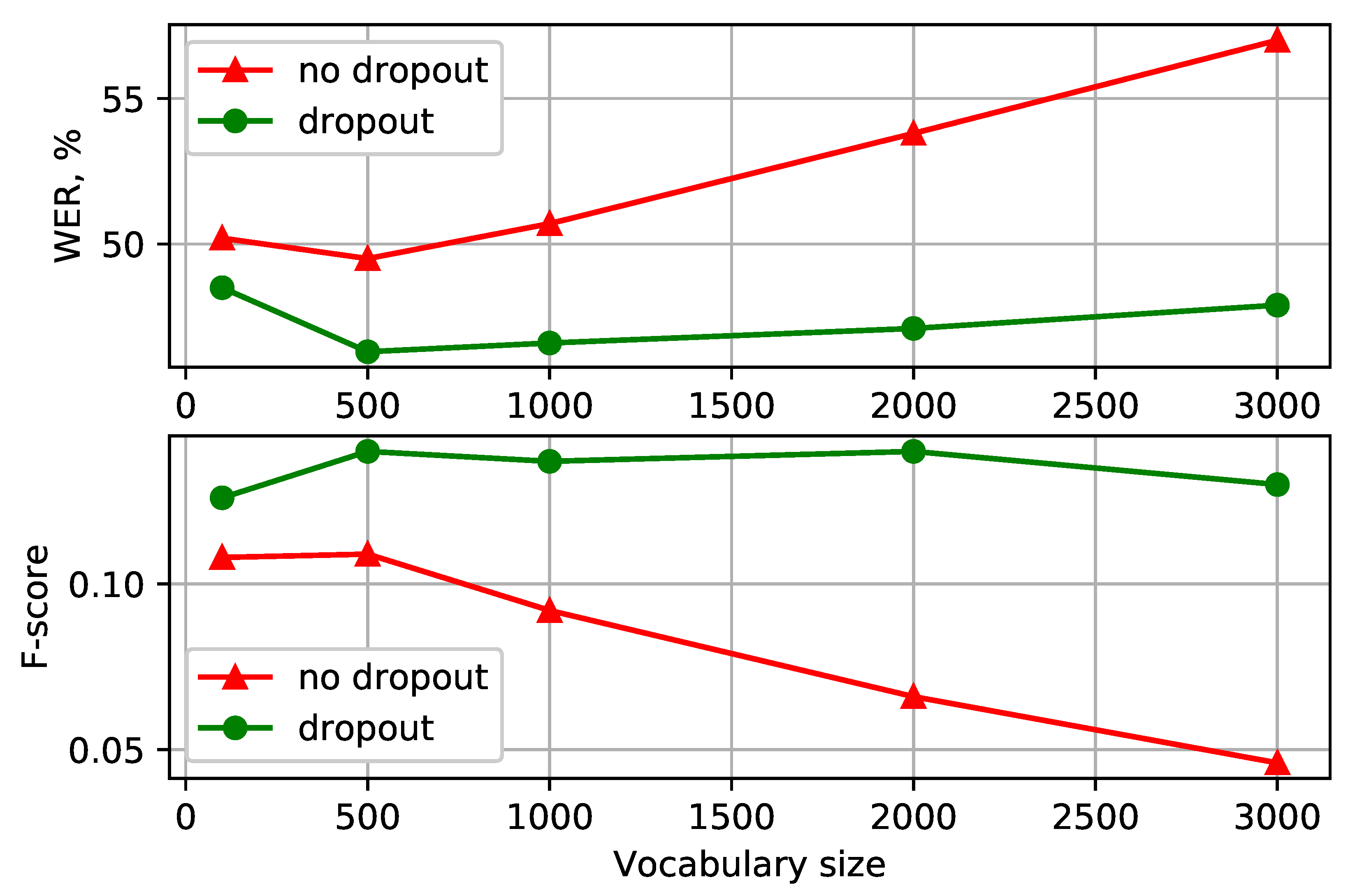

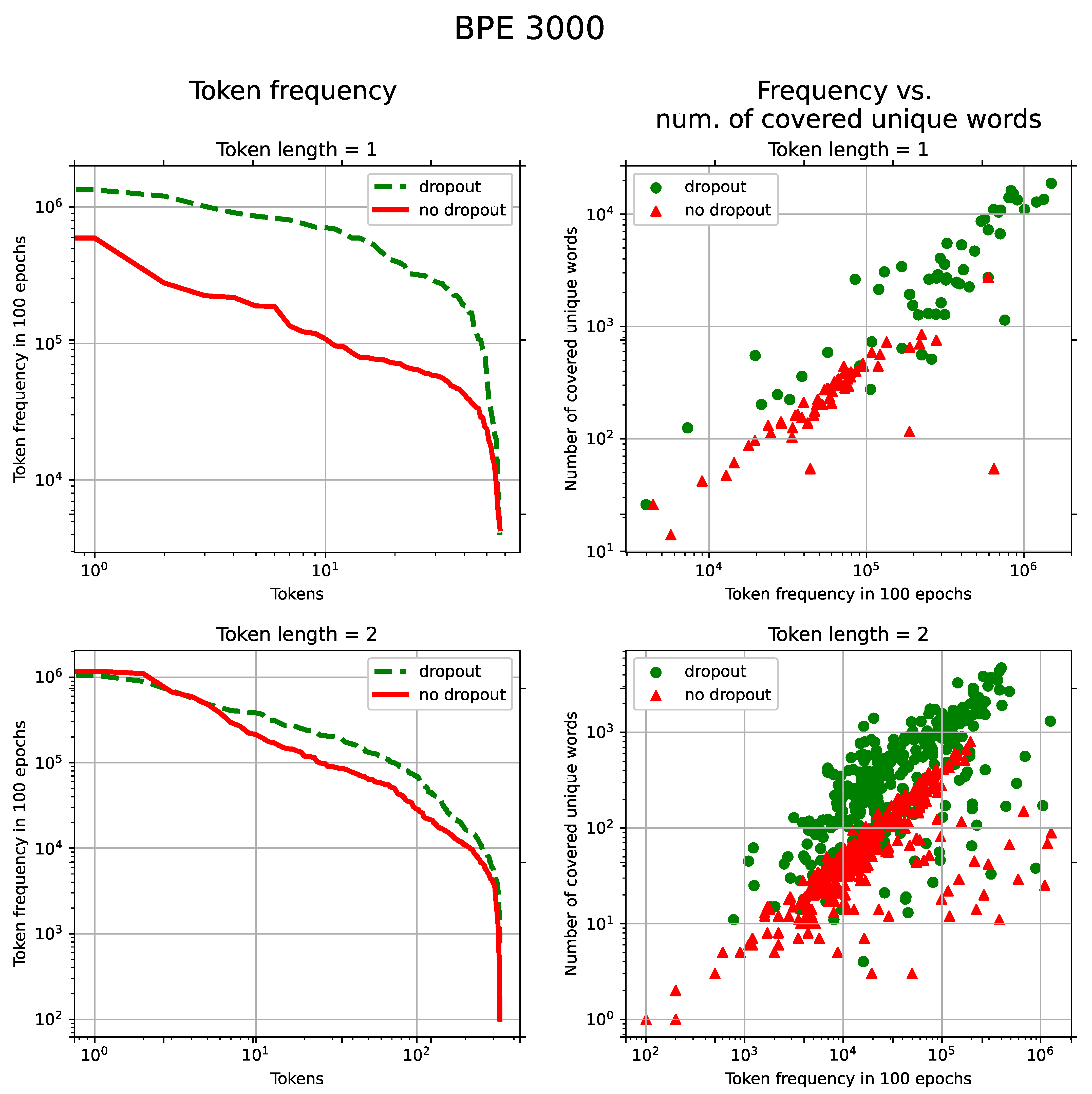
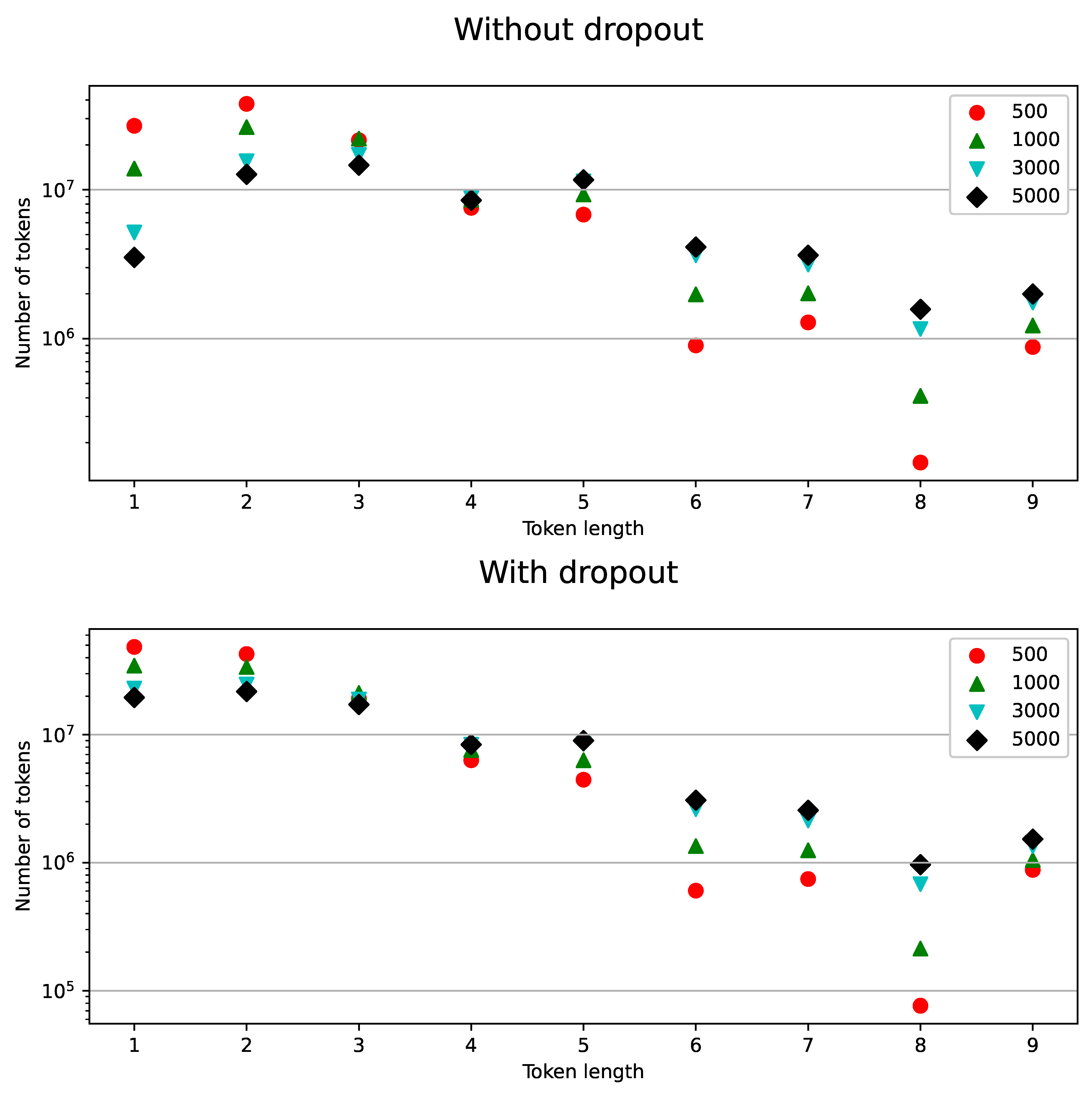
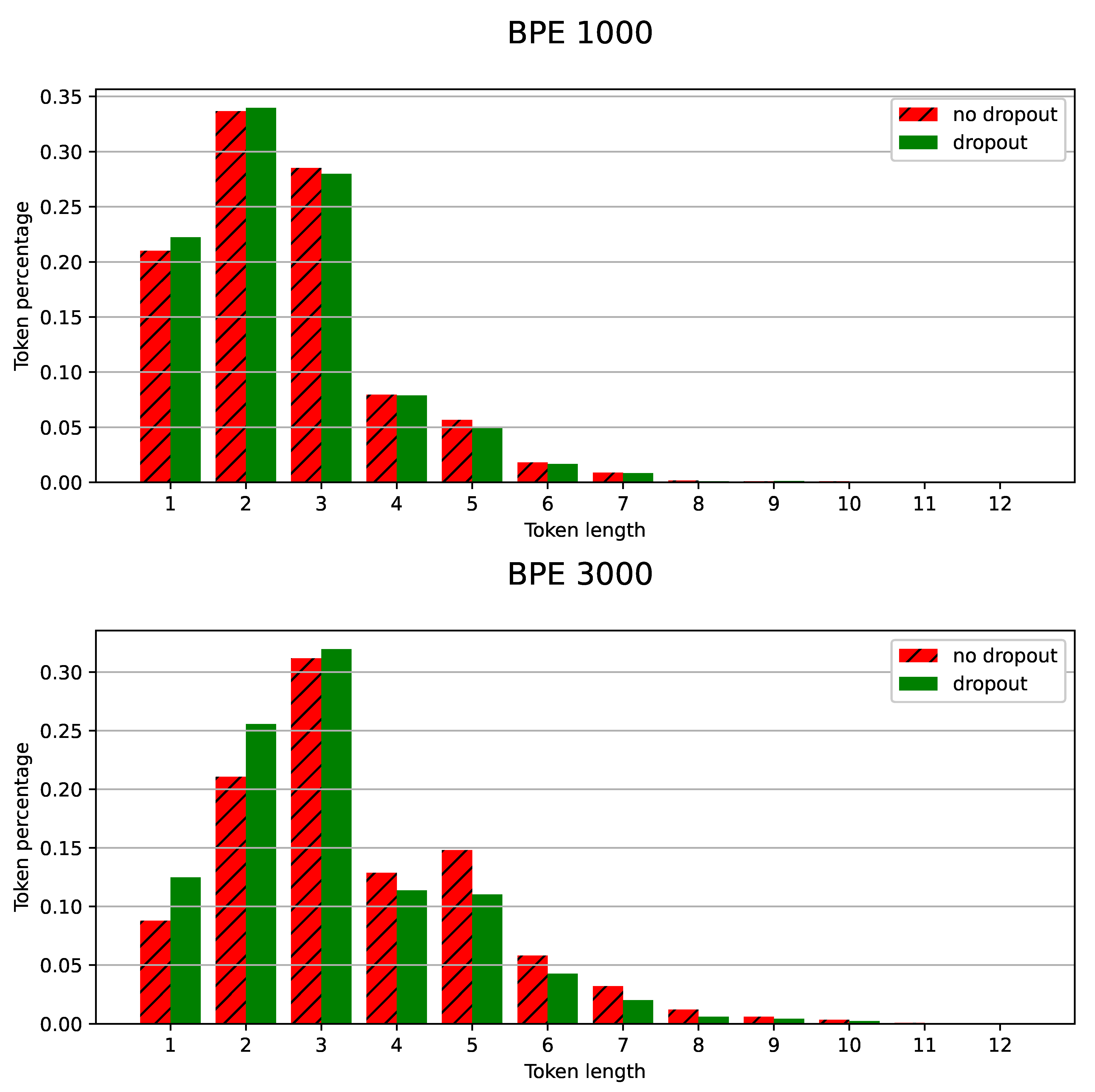
| Vocab Size | BPE-Dropout | WER (%) | Precision | Recall | F-Score |
|---|---|---|---|---|---|
| char | - | 53.0 | 0.067 | 0.165 | 0.095 |
| 500 | - | 46.1 | 0.114 | 0.152 | 0.130 |
| + | 44.4 | 0.120 | 0.209 | 0.153 | |
| 1000 | - | 46.5 | 0.130 | 0.144 | 0.137 |
| + | 44.0 | 0.126 | 0.194 | 0.153 | |
| 2000 | - | 47.4 | 0.126 | 0.118 | 0.123 |
| + | 43.6 | 0.144 | 0.198 | 0.167 | |
| 3000 | - | 49.2 | 0.129 | 0.099 | 0.112 |
| + | 43.2 | 0.156 | 0.197 | 0.174 | |
| 4000 | - | 50.9 | 0.124 | 0.085 | 0.101 |
| + | 43.4 | 0.151 | 0.183 | 0.166 | |
| 5000 | - | 51.1 | 0.115 | 0.070 | 0.087 |
| + | 45.0 | 0.137 | 0.160 | 0.148 |
| Vocab Size | BPE-Dropout | WER (%) | Precision | Recall | F-Score |
|---|---|---|---|---|---|
| char | - | 51.2 | 0.090 | 0.162 | 0.116 |
| 100 | - | 50.2 | 0.087 | 0.143 | 0.108 |
| + | 48.5 | 0.101 | 0.167 | 0.126 | |
| 500 | - | 49.5 | 0.095 | 0.126 | 0.108 |
| + | 46.3 | 0.117 | 0.172 | 0.140 | |
| 1000 | - | 50.7 | 0.088 | 0.096 | 0.092 |
| + | 46.6 | 0.118 | 0.161 | 0.137 | |
| 2000 | - | 53.8 | 0.070 | 0.061 | 0.066 |
| + | 47.1 | 0.124 | 0.160 | 0.140 | |
| 3000 | - | 57.0 | 0.054 | 0.039 | 0.046 |
| + | 47.9 | 0.116 | 0.147 | 0.130 |
| model | BPE-Dropout | WER (%) | Precision | Recall | F-Score |
|---|---|---|---|---|---|
| Transformer | - | 49.2 | 0.129 | 0.099 | 0.112 |
| + | 43.2 | 0.156 | 0.197 | 0.174 | |
| Conformer | - | 42.9 | 0.188 | 0.142 | 0.162 |
| + | 40.5 | 0.194 | 0.201 | 0.197 | |
| Conformer+SP | + | 38.9 | 0.199 | 0.255 | 0.224 |
| Language | Model | CER (%) | WER (%) |
|---|---|---|---|
| Turkish | Our LF-MMI TDNN-F | (* 21.4) | 43.9 (* 38.6) |
| Our Conformer | 22.2 (* 17.3) | 38.9 (* 34.7) | |
| CTC-BLSTM [51] | - | 50.7 (* 45.8) | |
| BLSTMP+VGG-Multilingual [52] | 28.7 | - | |
| XLSR-Monolingual [53] | 26.1 | - | |
| XLSR-53-Multilingual [53] | 18.8 | - | |
| Georgian | Our LF-MMI TDNN-F | (* 25.4) | 51.6 (* 43.3) |
| Our Transformer | 24.6 (* 21.0) | 46.3 (* 41.7) | |
| BLSTMP+VGG-Multilingual [52] | 36.0 | - | |
| Multilingual hybrid fusion [54] | - | 32.2 | |
| XLSR-Monolingual [53] | 30.5 | - | |
| XLSR-53-Multilingual [53] | 17.2 | 31.1 |
Publisher’s Note: MDPI stays neutral with regard to jurisdictional claims in published maps and institutional affiliations. |
© 2021 by the authors. Licensee MDPI, Basel, Switzerland. This article is an open access article distributed under the terms and conditions of the Creative Commons Attribution (CC BY) license (https://creativecommons.org/licenses/by/4.0/).
Share and Cite
Laptev, A.; Andrusenko, A.; Podluzhny, I.; Mitrofanov, A.; Medennikov, I.; Matveev, Y. Dynamic Acoustic Unit Augmentation with BPE-Dropout for Low-Resource End-to-End Speech Recognition. Sensors 2021, 21, 3063. https://doi.org/10.3390/s21093063
Laptev A, Andrusenko A, Podluzhny I, Mitrofanov A, Medennikov I, Matveev Y. Dynamic Acoustic Unit Augmentation with BPE-Dropout for Low-Resource End-to-End Speech Recognition. Sensors. 2021; 21(9):3063. https://doi.org/10.3390/s21093063
Chicago/Turabian StyleLaptev, Aleksandr, Andrei Andrusenko, Ivan Podluzhny, Anton Mitrofanov, Ivan Medennikov, and Yuri Matveev. 2021. "Dynamic Acoustic Unit Augmentation with BPE-Dropout for Low-Resource End-to-End Speech Recognition" Sensors 21, no. 9: 3063. https://doi.org/10.3390/s21093063
APA StyleLaptev, A., Andrusenko, A., Podluzhny, I., Mitrofanov, A., Medennikov, I., & Matveev, Y. (2021). Dynamic Acoustic Unit Augmentation with BPE-Dropout for Low-Resource End-to-End Speech Recognition. Sensors, 21(9), 3063. https://doi.org/10.3390/s21093063






